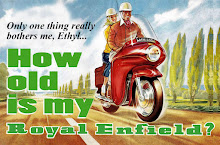I was confused when a member of the
Royal Enfield Yahoo group asked this question:
"Would like to find out what is different in terms of mechanical and price of Royal Enfield and Enfield. I own an Enfield instead of Royal Enfield. But friend said it is of less value and mechanicals are so much different than Royal Enfield. Please advise."
I (wrongly) assumed that he was asking if the words "Royal Enfield" on the tank make a motorcycle more desirable than one with just "Enfield" on the tank.
I certainly don't consider my 1999 "Enfield" Bullet automatically less valuable just because, the very next year, the Bullet began being imported to the U.S. labelled as a "Royal Enfield."
The question is much — much — more complicated than that, as other members of the Yahoo group realized. The answer doesn't (necessarily) have much at all to do with the name on the tank. At various points, the factory in India has used the name "Enfield" and "Royal Enfield."
Here's the real issue: the very early Bullets in India had a great deal of British content in them. Some people consider these earlier machines more desirable than the all-Indian motorcycles that came later.
Graham Scarth, chairman of the
UK Royal Enfield Owners Club, gave members of the Yahoo Group a capsule history. And he added more detail in an email to me. In sum:
"...Separate Madras Motors from Enfield India as they are two completely different companies, even though the owners of Madras Motors were part of the Enfield India set up.
"Madras Motors received complete finished motorcycles from Redditch (England), with the ledgers showing their last batch of 50 bikes as dispatched in early June, 1956.
"Enfield India started receiving the Bullet in CKD (Completely Knocked Down) kit form from mid July 1956 onwards.
"At first, Enfield India assembled the 350cc Bullet from complete kits of parts supplied by the UK factory. These machines are to the 1954 UK specification, with the machines sent to Madras Motors in 1955 and early 1956 having a different frame.
"Over subsequent years, Enfield India begin to make the components themselves until the bike is of entirely Indian manufacture. I do not know the exact year of this complete 'independence,' but it is not as early as commonly believed.
"Whilst the UK built bikes used Imperial bearings throughout production, the Enfield India factory changed to metric ones in the engine in 1974. I would assume the gearbox changed at the same time, but cannot confirm this. I do not know when the change took place for the wheels.
"The Madras (now Chennai) factory continued to trade as Enfield India until they were taken over by Eicher Industries in the early 1990s. Eicher changed the name to Royal Enfield."
Member David Hill added that "During the period of concurrent production (1955-1962) Redditch carried out some retooling and redesign and regearing which were never adopted by the Indian version. Thus the Indian Bullet remained essentially the 1955 frame and 1960 engine."
There were changes made in Chennai as well. Tom Lyons of Ace Engineering explained that "In the 500 models, the Indian-made cylinder heads have a larger inlet port than the UK-made Bullet had. The Indian-made cams have different valve timing. The Indian made engine has a different carb and manifold. Later Indian-made Bullets have many metric threaded fasteners. Most of the parts are interchangeable, but there are some differences."
So are the British cams better than Indian cams? Lyons answered: "It depends on the ports." Aftermarket parts are available that could be better than either, he wrote.
OK. So how to answer the original question? Are those early Bullets from India more valuable than later Bullets from India?
There is no doubt that many think so, although 50 years of maintenance and restoration to any one motorcycle would surely have reduced the distinction by now.
 |
| Was this Royal Enfield once more British than Indian? |
As an illustration, consider the veteran Royal Enfield Bullet pictured here, which is
for sale on CraigsList in Durham, N.C.
The seller describes it as a "British made 1965 Royal Enfield Bullet 350. Rebuilt in India with some Indian-made parts."
Its appearance, with the Indian style front license plate and modern looking turn signals, suggests it did service in India, and may be newer than 1965. However, the front and rear fenders look like they could be British designed.
Does that make it more desirable? Perhaps once it was. It now "
needs some tinkering to start."



















































